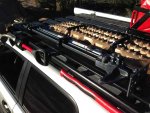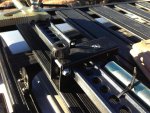Seat Heater Switches

This is a follow up to a project I started on last spring, when the weather was starting to warm up. I installed a leather interior in the 4Runner, and in the process of the swap out I installed seat heaters under the leather upholstery. Since the weather was headed toward spring and summer, I didn't get to the wiring portion of this modification. Well, the hills of Arizona are cooling off. I was also handed a directive from my boss to make this happen. I can't blame her much on that as I wanted them too. Getting soft I guess.
Plan A revisited
My lofty plans were to install Toyota factory seat heater switches and masterfully tap into the wiring harness available with the switches to meet the needs of the heaters. A close friend even sourced the wiring diagrams for the switches and what each wire pin was for. Thanks Will. But after staring at the diagrams and the wiring of both systems for quite some time, I talked my way out of it. It wasn't going to be an easy modification, and I was not comfortable that the result would work. So back to plan A.
The Wiring
The wiring harness was pretty straight forward. Install switch, plug in relay, fasten grounds to vehicle ground and source switched power. The placement of the switches was a subjective matter. Several locations were available. I looked at installing the switches in the heads of the OEM seat heater fill caps in the center console first. The switches are close to the same width as the cap material, and there is a significant amount of material under the surface of the cap. I wasn't sure if the switches would seat well. I decided to install them in the vertical surface at the front of the center console. Out of the way, intuitive touch control, and very easy access for wiring. The switches are designed for Low/Off/High positions, so you can tell with the pad of your finger what setting you are in. Clearance behind the face of the console was sufficient to run the wiring. I ran the harness for each seat into the center console, and attached the grounds to a transfer case cover screw. I ran the hot leads into the dash and up around the drivers side console to the OEM fuse block. Each seat has a draw requirement of 11.5 Amps, or so the instructions note. The source wire it a 16 gauge, which I thought interesting. There are 2 unused switched fuse locations in the block. I used a couple NAPA tapa circuit fuse links to connect into the block. They are a neat little gizmo that you can plug into a fuse block and tap a circuit onto it while still supplying that fuse location with a fuse. I inserted 15 Amp fuses in each. The fuse link listed a rating of 10 amps max, but I am not using any of the original location capacity so I believe we will be alright here. Pretty slick. But I don't believe this is a permanent solution. They stick out of the OEM block and don't allow the fuse block cover to be attached again. I think a more permanent switched power auxiliary fuse block would be a more elegant solution. It just got added to the list.
In the mean time, I have heated seats in my Trail Edition now. And much better ones than the 100 had. The 100 Series had a heater in the lower seat only, and it was about half of the length of the cushion. These bad boys run from my knees to my neck. Ah, the good life. A toasty butt.
Cheers,










